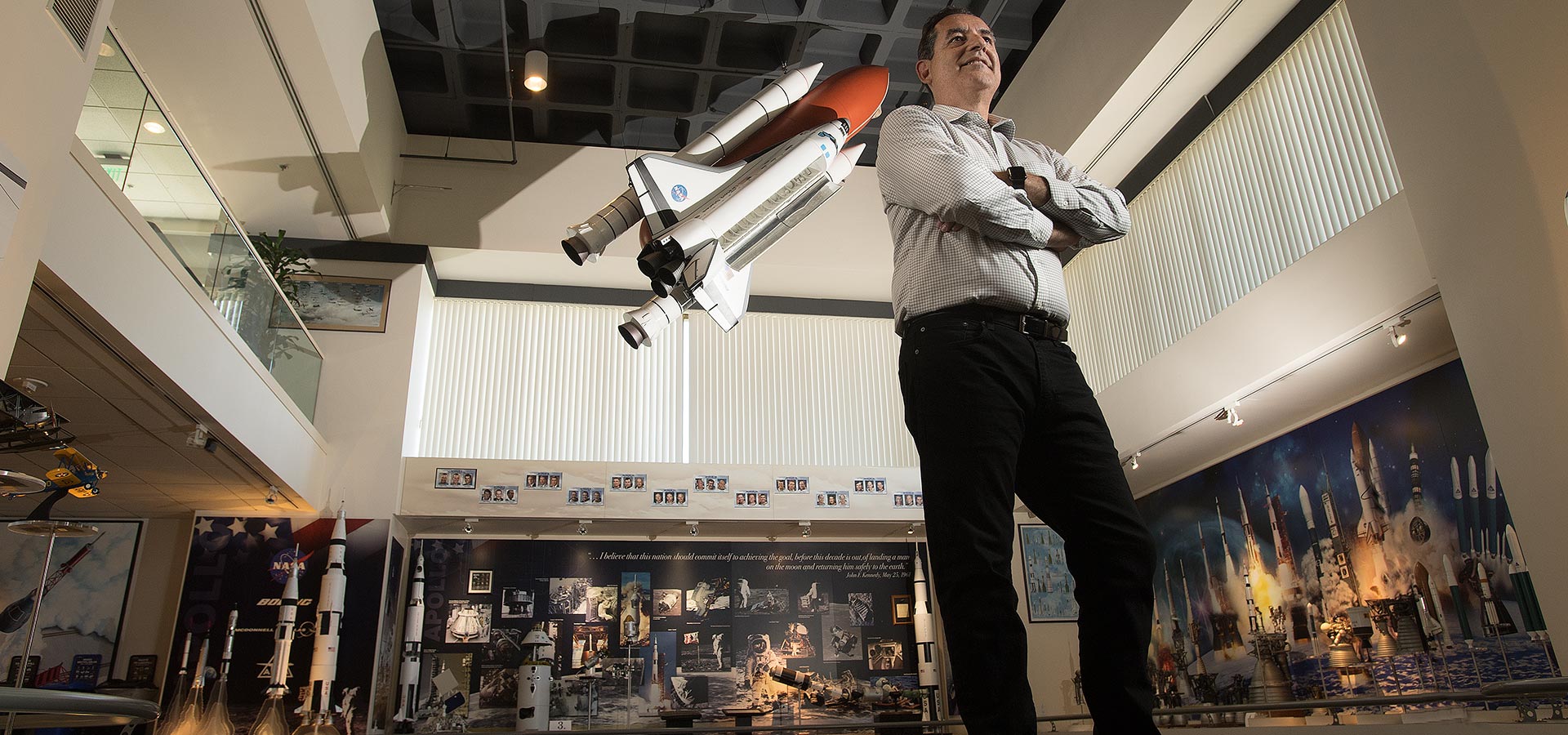A New Trajectory
'I was Capable of Something Greater'
By Chris Park
Manuel Beltran (’89, aerospace engineering) is an aerospace savant. As the chief software architect within Boeing AvionX, Beltran leads a team of engineers working around the world to revolutionize the avionics industry. His work for NASA in the 1990s was so significant that the agency still calls him to inquire about launch readiness systems he established.
Beltran’s successes belie a troubled youth riddled with bad decisions that nearly wiped away his potential — and his life along with it.
Beltran’s family emigrated from Mexico to the city of Santa Anta, and he was the first in his family to be born in the United States. His father owned a construction and landscape company, and his mother maintained the household. They worked hard to establish themselves, continuing
a lineage of hardworking landowners, professionals and entrepreneurs. Beltran sought to model his work ethic in the same way.
When his parents divorced early in his life, Beltran and his two sisters were devastated. He says it sent him into a downward spiral. He isolated himself, avoided eye contact and dressed differently. At 12, Beltran joined a gang.
“I guess I was looking for validation and a challenge. I watched as others admired the gang jackets the guys wore,” he says. “It looked like a sure way to be likewise admired by association.”
That same year, he started experimenting with drugs. By 13, he received three traffic tickets. Beltran’s efforts at self-sabotage were progressing apace.
But Beltran excelled academically at Santa Ana’s Spurgeon Intermediate School. He was promoted from the sixth grade to the eighth grade and earned a place in a program for academically gifted students. He says the school didn’t have the staff to work with anomalies like him — a very smart but very troubled kid.
Beltran had a miserable freshman year in high school. During a meeting to review his transcripts, his sophomore counselor asked what he was considering for a career. The high school student shrugged, mentioning a vague interest in drafting. His counselor said his test scores were that of an engineer.
The encouragement was the first spark in a life that had the potential to lift off.
“At that very moment I decided to align my choices to become an engineer, not because I knew what that was all about, but because someone saw in me that I was capable of something greater,” Beltran says.
He began working with the city of Santa Ana and was part of the Buena Gente (translated to “good people”) program as a photographer. The program brought rival gangs to meet with each other and work out their differences with conversation instead of violence.
Things were getting better but then got a lot worse.
On the afternoon of Nov. 21, 1981, two local gangs seeking to reestablish authority went to war. Twenty gangsters descended upon Beltran and four of his friends. Beltran had the opportunity to run. Instead, he stood with his friends, ready to die. Miraculously, while two were hurt, Beltran and his friends survived.
“I should have died that day,” Beltran says. “A day does not go by that I don’t think about that day. I vowed to do good and make good choices from that day forward. I’ve kept that vow.”
At 17, he entered junior college and at 23 transferred to Cal Poly Pomona. He enrolled in the aerospace engineering program with a minor in computer science. He focused on space-related courses, and with an eye to the future, he took all the artificial intelligence classes available. Beltran envisioned that AI systems would be integral for the future of flight, and it was that vision that his senior project was predicated on. His faculty advisor was unsure but took a leap of faith.
Beltran and his professor’s trust were vindicated. For his project, Beltran developed a system designed to help test pilots reduce their workload in the assessment of an airplane’s flying qualities. It was a hit with the alumni review panel and got him his first engineering position at Rockwell International.
“My Cal Poly Pomona education literally made my dream come true,” Beltran says. “Each school has a particular emphasis, tradition or niche. Because of the rich aerospace history of the greater LA area, Cal Poly Pomona has a distinct advantage over many schools.”
He made use of his advantages. Early in his career, he built a neural network (a computer system with an underlying structure similar to how a human brain operates) for NASA at a time when AI was nascent. The system evaluated the health of a space shuttle’s auxiliary power unit in real time to help the launch operations teams determine whether or not to launch a shuttle within 20 seconds of take-off. This system would prove to be critical for NASA and became part of the launch readiness checklist.
Cal Poly Pomona helped Beltran discover his best self and grow beyond what he thought was possible. He urges today’s students to tap into their own potential.
“Commit yourself to a lifetime of learning, growing and giving. Start making better choices today. Have the confidence that you have something to contribute to the solution,” he says.
“Don’t let yourself be intimidated by old ways of thinking. The most valued engineers are the ones that innovate within the constraints of form, fit or function. Most importantly, own it.
"Be the expert within your domain. Don’t settle to just be one of the team. Rise to lead that team to excellence.”
